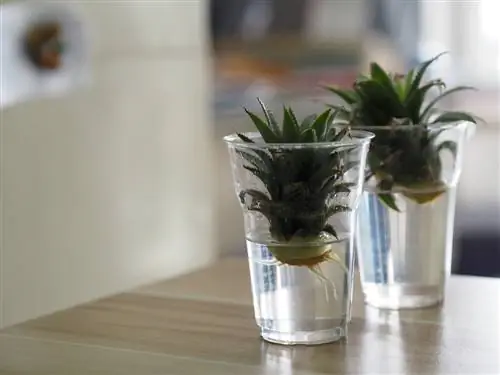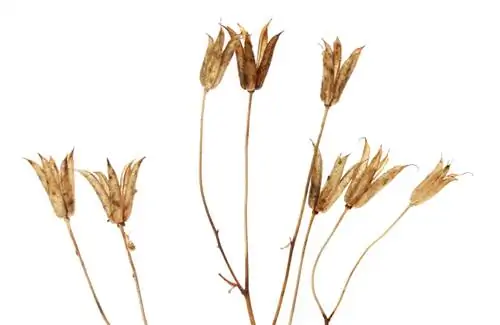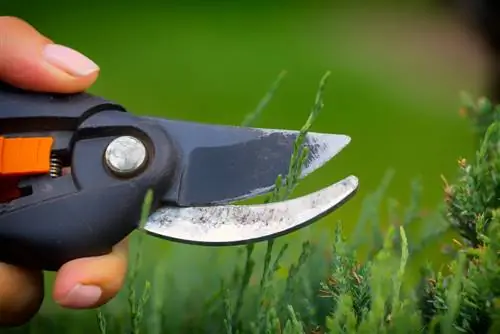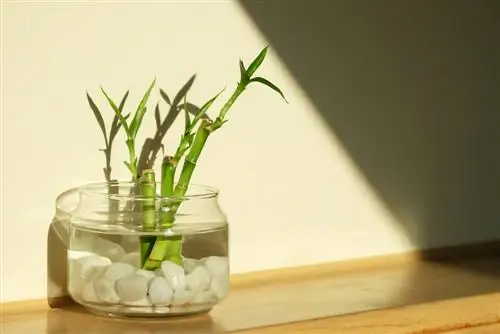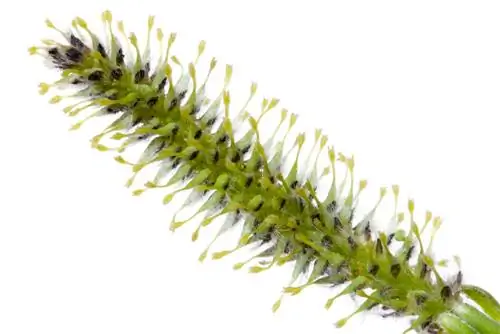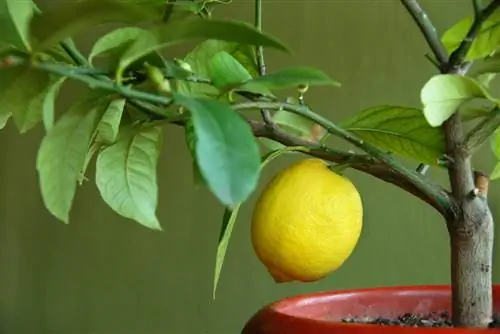- Author admin [email protected].
- Public 2023-12-16 16:46.
- Last modified 2025-06-01 06:02.
Read everything you need to know about flowers and roots in the pineapple plant profile here. You can find out how to plant a stalk correctly here. This is how you care for ornamental pineapples in an exemplary manner.
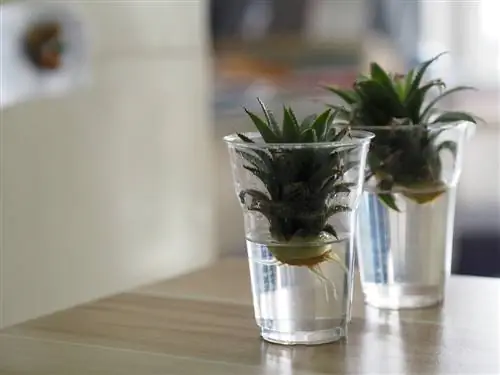
What is the pineapple plant and what properties does it have?
The pineapple plant (genus Ananas) belongs to the Bromeliad family and comes from South America. It is a herbaceous fruit plant with heights of 60 to 150 cm, lanceolate and toothed leaves, and cone-shaped flowers. The fruit of the pineapple plant is an edible berry.
Profile
- Scientific name Genus: Pineapple
- Family: Bromeliads (Bromeliaceae)
- Origin: South America
- Type: herbaceous fruit plant
- Growth height: 60 to 150 cm
- Flower: cone-shaped, many-flowered
- Flowering period: July to January
- Root: adventitious roots
- Leaf: lanceolate, serrated
- Fruit: Berry
- Use: decorative ornamental plant
- Winter hardiness: not hardy
Bloom
The flower is the attractive centerpiece of a pineapple plant, surrounded by a lush rosette of leaves. Even in its early stages, the flower shape is reminiscent of the decorative fruit. The following characteristics characterize the flower of a pineapple plant:
- Shape: cone-shaped to spherical with a tuft of leaves at the top
- Inflorescence: spike with up to 100 individual flowers, arranged in spirals
- Flower bracts: 3 short, fleshy sepals and 3 longer, purple or violet petals
- Flower stem: up to 30 cm long, significantly shorter for ornamental pineapples
In order for your pineapple plant to decide to bloom, it takes a little horticultural persuasion. The following video reveals how the trick works:
Video: Green life hack - making a pineapple plant bloom
Roots
A pineapple plant grows roots in two places. Because the bromeliad family thrives terrestrially, the main roots sprout from the nodes at the bottom of the trunk. These adventitious roots branch numerously in all directions. The roots reach a depth of up to 100 centimeters and spread laterally up to 200 centimeters.
A pineapple plant can also develop roots in the leafy tuft. These root strands grow from the leaf axils up to a length of at least 10 centimeters. If water and nutrients accumulate in the leaf rosette, the mini roots pass the valuable goods on to the leaves, flowers and fruit.
leaves
The leaves of a pineapple plant gather to form a sprawling rosette. The following characteristics characterize the foliage of an ornamental pineapple:
- Shape: narrow, linear to lanceolate
- Length: 50 to 120 cm
- Width: 2 to 7 cm
- Leaf edge: sharply serrated, curved upwards
- Leaf cross section: crescent-shaped
- Leaf tip: thorny, pointed
- Consistency: thick, resistant to bending
A crown of leaf-like, toothed bracts sits enthroned on the ripening fruit.
Fruit
The fruit of an ornamental pineapple is edible. The culinary enjoyment of eating it is debatable. The he althy ingredients in the yellowish-golden flesh of a pineapple are undeniable. The following table gives the data:
| Nutritional value | 100 g pineapple | Vitamins | 100 g pineapple | Minerals | 100 g pineapple |
|---|---|---|---|---|---|
| Calorie | 56 kcal | Vitamin C | 20 mg | Potassium | 172 mg |
| Kilojoules | 232 KJ | Vitamin A | 10 µg | Magnesium | 17 mg |
| Carbohydrates | 12, 4 g | Vitamin B 1 | 0.08 mg | calcium | 16 mg |
| Proteins | 0, 5 g | Vitamin B 6 | 0.08 mg | Sodium | 2 mg |
| Fat | 0, 2 g | Vitamin E | 0, 1 mg | Iron | 0, 4 mg |
Please note: Eating an unripe pineapple is unhe althy. There is a risk of nausea and stomach cramps.
Planting stem
The growth of roots from the leaf axils turns every pineapple head into an XXL cutting. Resourceful hobby gardeners don't miss this opportunity and use the stalk for pineapple propagation for free. The following instructions explain how to easily grow an ornamental pineapple:
Material and tools
- 1 ripe pineapple (ideally unrefrigerated flying pineapple)
- 1 sharp, disinfected knife
- 1 glass
- 1 planter with drain hole
- 1 plastic bag with string
- Growing soil with a pH value of around 5 (coconut soil, palm soil or cactus soil with sand)
- Expanded clay, lava granules or grit
- Charcoal powder
- Stale tap water or collected rainwater
- Thornproof Gloves
Preparing fruit
Take the fruit in one hand. With your other hand, turn the leaf back and forth a few times. If the stalk has separated from the pulp, pull out the stalk. Remove several rows of bottom leaves. During this process you expose the sprouting points of the roots. Cut off the yellowish, fibrous remainder of the pulp smoothly and straight with a knife. In the final step of preparation, dip the damp stalk in charcoal powder to prevent rot and mold formation.
Rooting leaves
First let the prepared cuttings root in water. This is beneficial for rapid root growth and a great experience for the whole family. This is how it works:
- Let the stalk disinfected with charcoal dry for 3 to 6 hours
- Pour room temperature, soft water into the glass
- Place the stem in the water up to the lower edge of the leaf rosette
Place the leaf in a glass of water on the bright, warm windowsill at ideal temperatures of 20° to 25° Celsius.
Planting rooted stem
If small roots 5 to 6 millimeters long have formed on the leaf, you can plant the stem. To protect against waterlogging, cover the bottom of the pot with drainage made of expanded clay or lava granules. Fill the growing pot with permeable substrate and moisten it with a fine spray. Create a small depression in the potting soil. Plant the rooted offshoot in it just below the first leaves. Finally, put the plastic bag over the pot, which creates a warm, humid microclimate. Ventilate the hood for a few minutes every day.
Planting unrooted stem
You can skip rooting in the water glass and plant the prepared stalk directly in loose, slightly acidic soil. In this case, we recommend a transparent planter so that you can observe the growth of the roots. This procedure is recommended if handling the delicate roots on the cuttings is too delicate for you.
Location
The transparent hood has fulfilled its duty when the fresh leaves sprout. The pineapple plant should continue to stay in its bright, warm window seat. The optimal location should be like this:
- Sunny with 3 to 4 hours of sunshine in the morning or late afternoon
- Ideally on a west or east window
- On the south window with shading to protect against the blazing midday sun
- Warm with constant temperatures above 18° Celsius, during cultivation 25° Celsius
A high humidity of 60 percent in the immediate vicinity of a pineapple plant optimizes the site conditions. Avoid placing it above the active radiator. Set up a humidifier. Fill the coaster with lava granules and water. The evaporating moisture simulates a rainforest climate, while the inorganic material prevents harmful waterlogging.
Excursus
Color Revolution Pink Pineapple Fails
The world's largest fruit producer Del Monte dared to experiment with a revolutionary pineapple plant with pink flesh. The “Rosé” variety produces less of the enzyme that is responsible for the golden yellow flesh of classic pineapples. However, the pink color revolution is a result of genetic engineering, which is a source of anger for consumers and amateur gardeners. A failure with an announcement.
Care for pineapple plant
A home-grown pineapple plant is easy to care for. The following tips provide a compact overview:
Pouring
Your pineapple plant benefits from an evenly moist substrate without waterlogging. The tropical beauty can cope with short-term dryness better than wet feet. Always water with room temperature, soft water after a finger test. If in doubt, it is better to spray the leaves and let the soil dry for a few more days.
Fertilize
Add a liquid fertilizer to the irrigation water every two weeks from May to September. From October to April, extend the fertilization intervals to four to six weeks.
Repotting
You should repot a pineapple plant every two years. The best time is in spring. Choose a spacious planter that accommodates the expansive growth of the leaves. There should be at least three finger widths of space between the root ball and the edge of the container. Use a well-drained, slightly acidic substrate without peat.
Wintering
Your pineapple plant would prefer to overwinter in its usual location. If there is an active radiator under the window seat, a change of location away from rising, dry heating air is recommended. It is important to note that the tropical plant is not exposed to temperatures below 18° Celsius in winter.
Dry ends - what to do?
The pineapple plant reacts to too low humidity with dry tips. Spray the leaves regularly with lime-free water. Unfortunately, dried leaf tips cannot regenerate. Cut off the brown tissue until just before the green leaf area.
Popular varieties
Specialist retailers have beautiful varieties available for cultivation as houseplants:
- Variegatus: decorative ornamental pineapple, leaves with ivory-colored, sharply toothed edges.
- Baby Pineapple: Ornamental pineapple in small format, 15 to 30 cm tall, fruit diameter 9.5 cm.
- Corona: compact growth, colored foliage, fruit not suitable for consumption.
FAQ
How do pineapples grow?
Pineapples grow as herbaceous plants and are rooted in the ground. The club-shaped trunk does not become woody and grows up to 35 centimeters high. Spread across this trunk are narrow leaves up to 120 centimeters long, which are arranged in a spiral to form a spreading rosette. An inflorescence stem that is up to 30 centimeters long rises from this cone of vegetation. The cone-shaped flower is made up of numerous individual flowers and looks very similar to a pineapple fruit. Fruit formation occurs with or without fertilization as a cluster of berries with yellowish pulp.
How big does a pineapple plant get?
A potted pineapple plant grows 80 to 100 centimeters high and 60 to 80 centimeters wide. Specialist retailers offer small varieties especially for cultivation as houseplants, such as baby pineapples, mini pineapples or dwarf pineapples with a height of 15 to 30 centimeters. The compact variety “Corona” grows up to 45 centimeters tall.
Harvesting pineapples. How does it work?
You can recognize a pineapple that is ready to harvest by its juicy green head. The peel is light brown to orange in color. When lightly pressed with your finger, the pulp yields elastically. At the same time, the fruit exudes its typical pineapple scent. To harvest you will need a sharp knife and thorn-proof gloves. Stabilize the fruit with one hand while cutting off the pineapple including the stem with the other hand.
Are pineapples poisonous to cats?
Different statements on this question are circulating online. We wanted to know exactly and asked veterinarians. Ripe pineapples are poisonous to cats in large quantities. If your loved one nibbles on an unripe fruit, even small amounts can cause distressing stomach problems and nausea.

